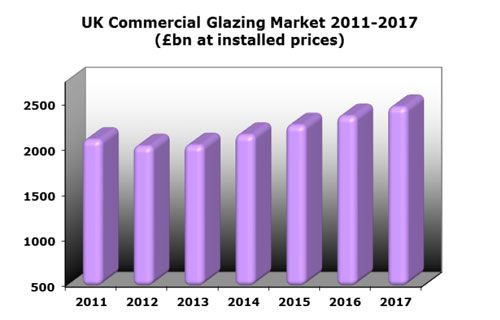
 The ‘Commercial Glazing Market Report – UK 2015-2019 Analysis’, recently published by AMA Research reveals that following a ‘difficult period’, the commercial glazing market saw a ‘modest increase’ in 2013, followed by significant growth in 2014, which appears to have been sustained in 2015.
The ‘Commercial Glazing Market Report – UK 2015-2019 Analysis’, recently published by AMA Research reveals that following a ‘difficult period’, the commercial glazing market saw a ‘modest increase’ in 2013, followed by significant growth in 2014, which appears to have been sustained in 2015.
According to the report, growth in 2014/15 has been mainly driven by rising demand in the office construction sector and there are currently signs of growing demand for new grade A office space in London, as well as other cities, which is likely to stimulate growth for commercial glazing from 2016 onwards.
AMA says that construction output in the education sector has also been strong in 2014/15, which is surprising given the public sector capital budget cutbacks. The education sector is also likely to see growing demand with the roll-out of the Priority Schools Building Programme (PSBP) in England as the replacement for BSF, which should deliver £2.5bn worth of new schools to complete by 2017, and the University Technical Colleges programme and similar schemes in Scotland and Wales.
However, the AMA report found that not all sectors are performing well. In healthcare, the shift away from building large hospitals towards smaller primary care facilities has meant less demand for curtain wall, roof glazing and windows. The decline in high street retailing – as well as in retail parks and out-of-town developments – will probably continue, as online shopping continues to penetrate the market. In addition, the grocery multiple sector is also experiencing a major cutback in store development programmes, which will have negative implications for the glazing industry.
In terms of product sectors, commercial windows is the largest sector accounting for over 50% of sector sales, with curtain wall and ground floor treatments both substantial markets. Demand for curtain walling has been particularly buoyant in 2014/15 – growing by around 10% per annum and driven primarily by a recovery in office construction – particularly in London.
Roof glazing accounts for the smallest share at less than 10%, though rooflights are in demand for both commercial and domestic applications. Aluminium is still the dominant frame material in the commercial glazing market, but timber, PVC-U, steel and composites all have reasonable shares and sector strengths.
On the supply side, some product sectors have seen relatively little change other than some smaller companies going out of business, and among the systems companies the market has remained fragmented with no truly dominant suppliers.
Andrew Hartley, director of AMA Research said: “In the aluminium systems supply sector, the market is broadly split, with the 10 largest accounting for around 90% of this market. However, more difficult market conditions in 2012-2013 has led to a significant contraction among fabricators and installers, with several players ceasing trading, though order books have improved in 2015.”



